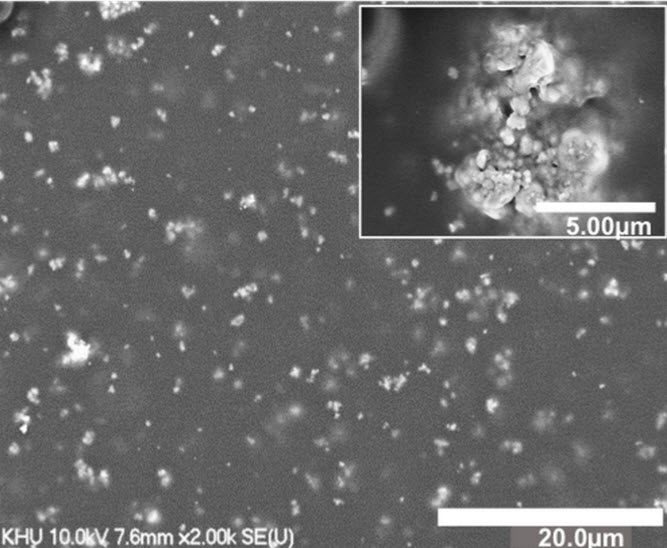Another key step toward flexible electronics
February 11, 2015

This electron microscope image shows tiny nanoparticles of bismuth ferrite embedded in a polymer film that enhances the unique electric and magnetic properties of bismuth ferrite and preserves these properties even when bent (credit: YoungPak Lee/Hanyang University)
Researchers from South Korea have taken a new step toward more bendable devices by manufacturing a thin film that keeps its useful electric and magnetic properties even when highly curved.
Flexible electronics have been hard to manufacture because many materials with useful electronic properties tend to be rigid. Researchers have addressed this problem by taking tiny bits of materials like silicon and embedding them in flexible plastics.
A team of physicists and engineers from South Korea took the same approach with bismuth ferrite (BiFeO3) — one of the most promising materials whose electronic properties can be controlled by a magnetic field, and vice versa. Such materials are called multiferroics and attract interest for applications like energy-efficient, instant-on computing.
The researchers synthesized nanoparticles of bismuth ferrite and mixed them into a polymer solution. The solution was dried in a series of steps at increasing temperatures to produce a thin, flexible film.
When the researchers tested the electric and magnetic properties of the film they found that their new materials improved properties remained even as the film was curved into a cylindrical shape.
“Bulk bismuth ferrite has crucial problems for some applications, such as a high leakage current which hinders the strong electric properties,” said YoungPak Lee, a professor at Hanyang University in Seoul, South Korea. Mixing nanoparticles of bismuth ferrite into a polymer improved the current-leakage problem, he said, and also gave the film flexible, stretchable properties.
Flexible multiferrorics could enable new wearable devices such as health monitoring equipment or virtual reality attire, Lee said. The multiferroric materials could be used in high-density, energy-efficient memory, and switches in such devices, he said.
The research is described in a paper published in the journal Applied Physics Letters. The authors are affiliated with Hanyang University, Seoul National University, and Hankuk University of Foreign Studies.
Abstract for Multiferroic properties of stretchable BiFeO3 nano-composite film
We present a simple drop-casting method for preparing multiferroic nano-composite film where BiFeO3 (BFO) nanoparticles (NPs) were evenly dispersed into polyvinyl alcohol (PVA) polymer. BFO NPs used in this work were synthesized by the conventional sol-gel method, having diameter of tens of nm and being in good crystallinity. The BFO NPs were loaded into highly-insulating PVA polymer solution as filler. The multiferroic properties of the film reveals ferromagnetic ordering due to the uncompensated spiral ordering and saturated ferroelectric curves due to the cut-off of current leakage. Moreover, the prepared films show high flexibility and their multiferroicities are preserved well even in high curved condition, reflecting the possibility for fabricating wearable devices based on multiferroic materials.